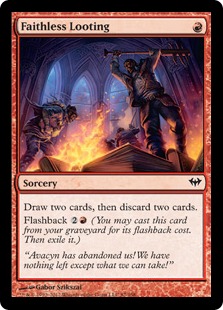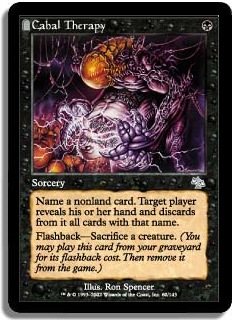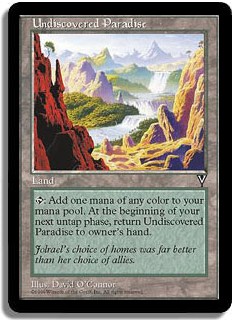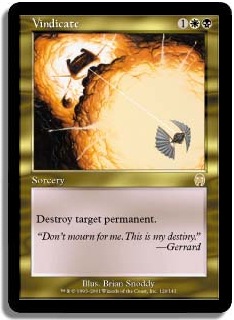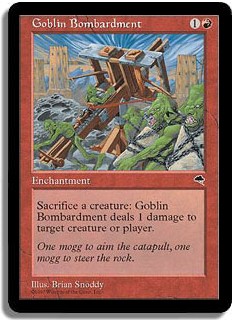As I’m sure you’re aware, the StarCityGames.com Invitational was this past weekend in Indianapolis. I finished decently (22nd), playing U/W Midrange in Standard (with three Cavern of Souls) and Zombies in Legacy. I’m a lot more excited about Zombies in Legacy, so I’d like to focus on that.
I played the deck because I expected Griselbrand to chase away some of the green decks, and I thought that adding Thoughtseize and Tidehollow Sculler to my Zombie deck would give it a reasonable matchup against combo decks.
I mention that I thought there would be less green because historically green decks are the decks I’ve been least successful against, largely because of Scavenging Ooze.
In the eight rounds of Legacy at the SCG Invitational, I never played against a combo deck, and I played against green decks five times. So my hopes about the metagame didn’t really pan out. I did manage to win three of my five matches against green decks, which gives me a little more confidence about the deck’s ability to fight a wider variety of strategies.
For the SCG Legacy Open on Sunday, I tweaked the deck to be better against green and worse against combo, so of course I played against Sneak and Show twice, Reanimator twice, Charbelcher and Dredge once each, and the only green deck I played against was a Veteran Explorer deck. Legacy’s pretty unpredictable.
Here’s the list I played at the SCG Legacy Open, since it’s the most updated version:
Creatures (18)
Lands (20)
Spells (22)
- 3 Goblin Bombardment
- 4 Cabal Therapy
- 4 Thoughtseize
- 2 Bitterblossom
- 4 Faithless Looting
- 4 Lingering Souls
- 1 Tragic Slip
Sideboard

I’ve written about this deck before, but for those who haven’t seen it played or read about it, it might be a little hard to figure out what’s going on here since it involves a lot of cards that don’t see much play in Legacy.
The idea is to discard cards that you would like to have in your graveyard to Faithless Looting and to get value out of being able to return creatures to play easily. The deck manages to get by playing relatively weak cards because there are incredible synergies between all of them.
The basic plan is to use discard early to stop your opponent from doing whatever their deck is designed to do, then establish a moderate clock that is particularly difficult for them to disrupt because your creatures don’t really die, and then to finish them off either by attacking or establishing a combo that lets you do something better like "burn them out" with Goblin Bombardment and/or Blood Artist.
In order to stop them from killing you, you have Thoughtseize, Cabal Therapy, and Tidehollow Sculler. Thoughtseize is excellent quick disruption that is particularly devastating when you also have Cabal Therapy, as it lets you name the perfect card. Cabal Therapy is at its best in this deck because the cost to flash it back is trivial. Tidehollow Sculler is relatively weak, but it serves as both an additional way to see the opponent’s hand for Cabal Therapy (as well as moderate disruption itself) and a Zombie to let you return your Gravecrawlers to play. Additionally, most combo decks aren’t great at killing creatures, so it’s pretty effective as a discard spell.
The clock is best established by the creatures that can’t block: Gravecrawler, Carrion Feeder, and Bloodghast. Ideally, you won’t have to cast Bloodghast because you’ll be able to discard it to Faithless Looting, but if you don’t have that luxury it’s ok to just pay BB and put it into play. You’ll still get value out of it later.
Carrion Feeder has B: put a +1/+1 counter on ~this~ if you have Gravecrawler" and landfall: put a +1/+1 counter on this for each Bloodghast in play or in your graveyard. It also grows whenever you chump block with a Spirit token, so it can get out of hand pretty quickly. The ability to sacrifice creatures in combat is also very important, since it can let you stop creatures with lifelink or creatures holding Umezawa’s Jitte from dealing damage in combat.
Goblin Bombardment works like a Carrion Feeder except that it doesn’t let you return your Gravecrawlers to play. Instead, it lets you kill all of your opponent’s creatures, which has generally been pretty good for me.
While I call this a Zombie deck, it actually utilizes more creatures with the "can’t block" mechanic than creatures from the Zombie tribe, and the zombies in the deck that can block, Tidehollow Scullers, generally don’t like to since then the opponent gets their card back. "Can’t block" is an awkward mechanic to build a deck around, because when you play against other creature decks you might find that blocking is actually a pretty important ability. To prepare for this issue, the deck plays a number of dedicated blockers in the form of Lingering Souls and Bitterblossom.
Lingering Souls fits the deck particularly well, since it fills the roll of "card you’re pretty happy to discard," but in this deck, you often find yourself not wanting to discard it because the additional creatures that can block are so valuable.
Bitterblossom was suggested to me after the SCG Invitational and makes a lot of sense, particularly with the addition of Blood Artist (which I’ll get to). I was a little worried that Bitterblossom might be too slow, but I think it played pretty well in the trial run. I’m not sure I’d want four, just because drawing multiple Bitterblossoms has always been awkward, but it’s certainly an interesting tool I’d overlooked.
I used to play Tombstalker and Geralf’s Messenger to help brawl with other creatures, but both were slow and problematic to cast, and the fact that Geralf’s Messenger comes into play tapped makes it very awkward to use specifically as a blocker. Blood Artist took their place, and I’ve been very happy with him. In the SCG Invitational I played two, but he over performed so I added the third. He’s awesome at making up for the fact that you can’t block because he’s so hard to race. You are well positioned to take full advantage of both the life gained and the life lost and to trigger him a huge number of times.
The single Tragic Slip is in the deck because I want to be able to kill large creatures, but I don’t think I can afford to play a lot of them in the maindeck. This is because the diversity of Legacy means that not every deck relies on creatures, so drawing several can be a significant liability.
As for the lands, I want to maximize fetch lands in order to get as much value as possible out of Bloodghast, but I’ve found that with only two copies of a dual land it’s too easy to get locked out of that color by Wasteland. The third basic Swamp is probably unnecessary now that I’ve cut Geralf’s Messenger and could probably become another fetchland or a second Undiscovered Paradise.
Undiscovered Paradise is an awesome tri-land with the added bonus of returning Bloodghast every turn, but it’s important not to play too many because drawing it as your only land can be awkward. This is because it will be slow to get a second land you draw into play, and drawing two of them is miserable, especially if you have 0-1 other lands. The fact that the deck never needs more than three lands and never wants more than five really helps limit the drawback on this land though, so I’d certainly be open to trying a second copy.
Sideboarding with this deck can be very difficult because of all the synergies. For a long time (through the SCG Invitational) I was cutting Cabal Therapy against creature decks because I needed to make room for removal. I’m currently of the opinion that the card is simply too powerful to cut but that I can’t really cut Thoughtseize and not it, so instead I just need to trim other cards to make room for it. I’m currently experimenting with siding down to three of each of the cards that are likely to get Surgical Extractioned (other than Faithless Looting) if I need to find room to help minimize the impact of that play.
This is definitely a deck that doesn’t want a ton of sideboard cards for any particular matchup though, since you can never really cut all that much without breaking up the synergies which takes power away from all the cards left in your deck.
Perish is a card I had moved away from a little because I found that green decks often have Wasteland and it can be hard to cast. But I’ve added a land since then, and it’s just so important against them and so powerful when you can cast it that it’s worth having at least two.
Go for the Throat is there largely as a faster answer to green creatures, especially Scavenging Ooze, but it has some upside in other places.
Pithing Needle was a card I hadn’t considered until it was suggested to me the morning of the SCG Legacy Open, so I didn’t have time to really think through it or test it and wanted to start conservatively. I liked the idea since it’s a great answer to Scavenging Ooze and Relic of Progenitus, and it does a lot of other awesome things. I think I sided it in against every single opponent I played against, so there’s a good chance that more than one is the right number.
Surgical Extraction is mostly there for graveyard decks, particularly Reanimator, but I play it over graveyard hate because it combines with my discard to create a reasonable plan against non-graveyard based combo decks as well. This is because I can potentially remove cards they rely on from their deck.
Disenchant and Vindicate are mostly there for cards like Leyline of the Void and Chalice of the Void (the Void is excellent against me), but both sometimes find other sweet things to do like kill Sneak Attack.
Darkblast is a great card against some creature strategies that’s particularly good in this deck because I can get a lot of value out of dredging, so I can happily "waste" several draws picking it up to kill off creatures while still furthering my own game plan.
Dark Confidant is excellent and comes in often. I don’t play him in the maindeck because he provides an easy way to make removal good against me without giving me any value and because drawing cards is generally better in sideboarded games when your cards are better suited to the matchup.
When I first played this deck at the SCG Legacy Open in Baltimore, I think people didn’t take it seriously, partially because I wasn’t confident enough to play it in the SCG Invitational. Now that I’ve had time to put some more work into it and with the printing of Blood Artist, I believe this is a real deck.
It has a solid internal game plan that lets it do something powerful against everyone. It has versatile disruption that lets you attack anything your opponent can do, and it has excellent answers to specific questions posed by the other decks I expect to face. It also attacks in ways people aren’t expecting or are likely well prepared to deal with. Most graveyard hate is relatively ineffective, and the few cards that work particularly well are rarely played and you still have answers to them (specifically Disenchant and Vindicate for Leyline of the Void and Grafdigger’s Cage).
I’m probably going to play this deck at Grand Prix Atlanta, but it’s hard to build and tune a deck more or less entirely by myself so there are still some things I need to figure out.
I’m still working on whether Tidehollow Sculler is the best disruption spell/best additional Zombie and how many are right to play. I’m still working on how much to push the token theme as compared to the graveyard/Zombie theme. As I discover that I’m really a Goblin Bombardment deck and I get additional copies with Blood Artist (except they’re better because they can work together), rewards for making a large number of creatures in any way possible increase. This pushes the value of cards like Bitterblossom and Mogg War Marshal, a card I have a good history with and probably my favorite red creature.
If I move that way, I could also further investigate additional sacrifice outlets like Greater Gargadon.
I’m excited to keep working on the deck since I think it still has a lot of room to grow, and I believe people don’t respect it as a serious deck the way that they should.
As much as I like to surprise people with the deck, I think I’ll have to get used to people knowing what I’m up to even if they haven’t read this article. Whenever I play it, a number of people express interest in the deck because it’s so fun and different, and I expect people to try it out soon. At some point it might even be worth playing a few games against if you play a lot of Legacy just so you’ll know what it can do if you play against it in a tournament.
For me, the deck is one of the most fun I’ve ever played. I love getting marginal value out of narrow synergies and winning with large numbers of small creatures, particularly used in unusual ways, so it might not be for everyone.
Anyway, this deck is good enough that I’m almost certainly playing it in Atlanta, barring stumbling on something amazing or the lure of Baleful Strix. I highly suggest trying it out.
Thanks for reading,
Sam
@samuelhblack on Twitter

